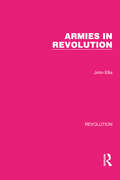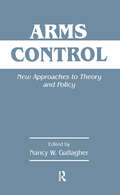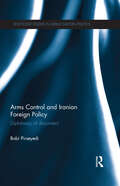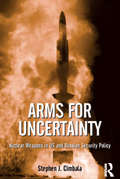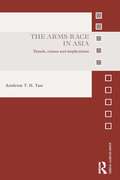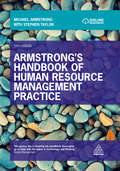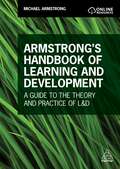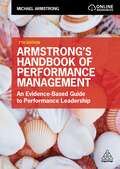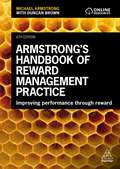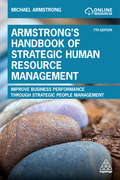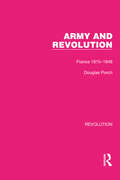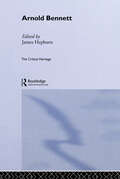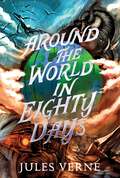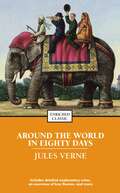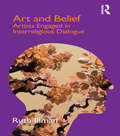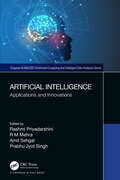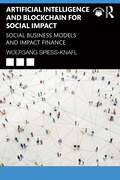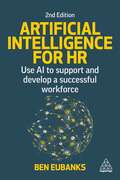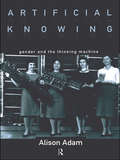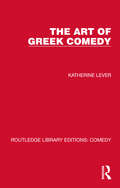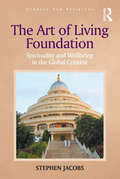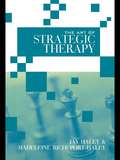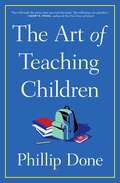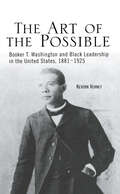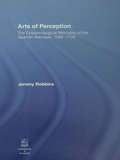Special Collections
Benetech’s Global Certified Accessible Titles
Description: Benetech’s GCA program is the first independent third-party EPUB certification to verify ebook accessibility. By creating content that is born accessible, publishers can meet the needs of all readers. Learn more: https://bornaccessible.benetech.org/
- Table View
- List View
Armies in Revolution
by John EllisThis book, first published in 1973, examines seven revolutionary armies ranging from Cromwell’s New Model Army to the Red Army of Mao Zedong. In each case it examines the mobilisation and organisation of the army, and the need to balance political ideals and aspirations with military cohesion and discipline, and social stability. This book is an outstanding example of a study of the relationship between the military and society, and shows that no revolution can succeed without an organised army and that few such armies can tolerate for long the ideology that created them.
Arms Control
by Nancy W. GallagherContents: Bridging the Gaps on Arms Control Nancy W. Gallagher. Arms Control in the Information Age Emily O. Goldman. A New Role for Transparency Ann M. Florini. Beyond Deterrence, Defence, and Arms Control Gloria Duffy. Nuclear Arms Control through Multilateral Negotiations Rebecca Johnson. The Impact of Govermental Context on Negotiation and Implementation: Constraints and Opportunities for Change Amy Sands. The Politics of Verification: Why How Much?' is Not Enough Nancy W. Gallagher.
Arms Control and Iranian Foreign Policy
by Bobi PirseyediSince 2003, when the world learned that the Islamic Republic of Iran had succeeded in secretly developing a capability to enrich uranium and separate plutonium, the question of Iran’s nuclear program has ranked high on the international political and arms control agenda. This book studies the IRI’s diplomatic operations in the issue area of arms control and demonstrates how arms control diplomacy has formed an integral part of the IRI’s foreign policy during the various phases of its history. Furthermore, it fills a gap in the research literature on Iran’s foreign and security policies by providing the first comprehensive account of Iranian arms control diplomacy under the Islamic regime. This book aims at reconstructing Iran’s diplomatic operations in four distinct thematic areas of arms control: conventional, chemical, biological, and nuclear arms control. It also looks at the diplomatic means by which the IRI’s leadership has tried to achieve its arms control objectives. This text also seeks to identify and examine the individual objectives that have guided Iranian policy choices in the domain of arms control. Finally, it places the reconstructed Iranian objectives into a broader context by elaborating on the fundamental values or foreign policy goals that the IRI’s arms control objectives have served. This highly informative and thought provoking volume will be valuable reading for students, researchers and academics, as well as for commentators and policy-makers interested in Middle East studies, Iranian studies, international relations and arms control.
Arms for Uncertainty
by Stephen J. CimbalaNuclear weapons are here to stay. They have survived into the twenty-first century as instruments of influence for the US, Russia, and other major military powers. But, unlike the Cold War era, future nuclear forces will be developed and deployed within a digital-driven world of enhanced conventional weapons. As such, established nuclear powers will have smaller numbers of nuclear weapons for the purpose of deterrence working in parallel with smarter conventional weapons and elite military personnel. The challenge is to agree proportional reductions in nuclear inventories or abstinence requiring an effective nonproliferation regime to contain aspiring or threshold nuclear weapons states. This is the most comprehensive view of nuclear weapons policy and strategy currently available. The author’s division of the nuclear issue into the three ages is a never seen before analytical construct. With President Obama reelected, the reduction and even elimination of nuclear weapons will now rise to the top of the agenda once more. Moreover, given the likelihood of reductions in US defense spending, the subject of the triad, which is covered in Chapter One, will no doubt be an important subject of debate, as will the issue of missile defense, covered in Chapter 10. This book provides an excellent analysis of the spread of nuclear weapons in Asia and the Middle East and the potential dangers of a North Korean or Iranian breakout, subjects that dominate current policy debates.
The Arms Race in Asia
by Andrew T.H. TanThis book is the first systematic examination of the emerging arms race in Asia. The global trade in arms is to a large degree underpinned by the strong demand for arms in Asia and the Middle East, the two largest arms export markets in the world. Of these two regions Asia has become particularly significant, led by the emergence of China and India as major powers. It is therefore not surprising that the rapid military modernisation in Asia, accompanied by significant increases in the size and sophistication of armed forces, has generated attention as to its trends, key characteristics, causes and implications. This phenomenon, which has become evident since the end of the Cold War, has also been widely described as an Asian 'arms race'. This book evaluates the key conceptual ideas which can shed light on this phenomenon, as well as examining the complex mix of internal, external and technological factors that have led to its emergence. The volume explores the way in which the arms race is leading ultimately to three distinctive blocs in the emerging geostrategic landscape: a loose bloc of US allies in the region; a counter-bloc of potential US adversaries; and a neutral bloc of states with industrial age armed forces whose allegiances will vary according to circumstances and geostrategic developments. The Arms Race in Asia concludes that if the emerging arms race is left unchecked, it is likely that Asia will increasingly become a region of instability, marked by conflicts and interstate wars. The book will be of great interest to students of Asian politics, strategic studies, defence studies, security studies and IR in general.
Armstrong's Handbook of Human Resource Management Practice
by Michael Armstrong and Stephen TaylorArmstrong's Handbook of Human Resource Management Practice is the bestselling and definitive resource for HRM students and professionals, which helps readers to understand and implement HR in relation to the needs of the business. It covers in-depth all of the areas essential to the HR function such as employment law, employee relations, learning and development, performance management and reward, as well as the HR skills needed to ensure professional success, including leadership, managing conflict, interviewing and using statistics. Illustrated throughout in full colour and with a range of pedagogical features to consolidate learning (e.g. source review boxes, key learning points, summaries and case studies from international organizations such as IBM, HSBC and Johnson and Johnson), this fully updated 15th edition includes new chapters on the HRM role of line managers, evidence-based HRM, e-HRM and the gender pay gap, further case studies and updated content covering the latest research and developments.Armstrong's Handbook of Human Resource Management Practice is aligned with the Chartered Institute of Personnel and Development (CIPD) profession map and standards and is suited to both professionals and students of both undergraduate degrees and the CIPD's level 5 and 7 professional qualifications. Online supporting resources include comprehensive handbooks for lecturers and students, lecture slides, all figures and tables, toolkits, and a literature review, glossary and bibliography.
Armstrong's Handbook of Learning and Development
by Michael ArmstrongThis brand-new book from HRM expert and bestselling author, Michael Armstrong, is an ideal companion for those studying learning and development (L&D) at third year undergraduate and postgraduate level as well as practitioners in L&D roles in the workplace. Armstrong's Handbook of Learning and Development provides an essential grounding in L&D theory including the components of L&D, the distinction between L&D and training, the relationship of L&D to human resources and knowledge management as well as coverage of the role of an L&D practitioner. In addition, this book covers emerging areas of learning such as digital, social and workplace learning as well as some of the latest developments including micro, connected and personalized learning as well as earning experiences. There is also coverage of how to use AI, gamification and curation to support learning and how to host both online and offline learning events. Supported by case studies and examples to put the theory in context, reflective exercises to consolidate learning and further reading suggestions to broaden knowledge and engagement with the topic, Armstrong's Handbook of Learning and Development is crucial reading for academic success. The final part of the book includes additional aspects of L&D including apprenticeships, leadership development and personal and interpersonal skills development. Online resources include lecture slides for every chapter, a lecturer manual and student manual.
Armstrong's Handbook of Performance Management
by Michael ArmstrongOptimizing staff performance is a key component of achieving outstanding business results. The new edition of Armstrong's Handbook of Performance Management is an essential companion for improving employee and organizational performance.From performance pay and giving feedback to managing underperformers, this handbook addresses all areas of performance management to enable students and practitioners to understand how to assess, measure and improve performance.This updated seventh edition contains new chapters on the meaning and development of performance management and managing performance with a remote workforce. It also covers performance leadership and multi-source feedback. Packed with examples to show how the theory applies in practice and exercises to consolidate student learning, Armstrong's Handbook of Performance Management remains an indispensable and engaging resource for securing effective performance across all aspects of the organization. Supporting online resources include an instructor's manual, lecture slides, a glossary and a literature review
Armstrong's Handbook of Reward Management Practice
by Michael Armstrong and Duncan BrownArmstrong's Handbook of Reward Management Practice is the definitive guide to understanding, developing and implementing effective reward strategies. It covers all the essential aspects of improving organizational, team and individual performance through reward processes, including financial and non-financial rewards, job evaluation, grade and pay structures, rewarding specific employee groups and ethical considerations. This revised and updated sixth edition incorporates the latest research and developments and contains updated coverage of equal pay and the gender pay gap, employee benefits and total reward and a new chapter on employee financial wellbeing.As with all of Armstrong's texts, Armstrong's Handbook of Reward Management Practice bridges the gap between academic and practitioner and is ideally suited to both HR professionals and those studying for HR qualifications, including master's degrees and the CIPD's intermediate and advanced level qualifications. Tips and checklists and can be found throughout, alongside case studies from organizations including General Motors, the UK National Health Service and Tesco. Online supporting resources include lecture slides and comprehensive handbooks for lecturers and students, which include learning summaries, discussion questions and exercises, literature reviews and glossaries.
Armstrong's Handbook of Strategic Human Resource Management
by Michael ArmstrongArmstrong's Handbook of Strategic Human Resource Management is a complete guide to integrating HR strategies with wider organizational goals and objectives approaches to achieve sustained competitive advantage. Supported by key learning summaries, source reviews and practical real-life examples from organizations including UNICEF and General Motors (GM), it provides coverage of HRM strategies in key areas of the function such as employee engagement, talent management and learning and development, as well as strategic HRM approaches in an international context. This fully revised seventh edition of Armstrong's Handbook of Strategic Human Resource Management contains new chapters on evidence-based strategic HRM, employee wellbeing strategies and HR analytics, as well as additional case studies and updated wider content to reflect the latest research and thinking. It remains an indispensable resource for both professionals and those studying HR qualifications, including undergraduate and masters degrees and the CIPD's advanced level qualifications. Online supporting resources include lecture slides and comprehensive handbooks for lecturers and students which include self-assessment questions, case study exercises, and a glossary and literature review.
Army and Revolution
by Douglas PorchThis book, first published in 1974, analyses the problems and mechanics of the Revolutionary movement in the army during and after the French Revolution. It charts the transition of the French army from the Revolutionary force of 1815 to the counter-revolutionary army which in June 1848 led the suppression of the European Revolutionary movement. By defining the scope of political of political unrest in the army between 1815 and 1848 – its causes, patterns and remedies – the author demonstrates that republican political ideology had only a limited appeal for the military and served more as a rallying point for discontent with the conditions of service.
Arnold Bennett
by James HepburnThis set comprises fory volumes covering nineteenth and twentieth century European and American authors. These volumes will be available as a complete set, mini boxed sets (by theme) or as individual volumes. This second set compliments the first sixty-eight volume set of Critical Heritage published by Routledge in October 1995.
Around the World in 80 Days
by Jules VerneIn this classic adventure story, a wealthy gentleman, Phileas Fogg, makes a bet that he can travel around the world in eighty days. Fogg and his servant set off immediately, determined to win this race against time. Little do they know they aren't making the journey alone.... Fogg has been fingered as the culprit in a bank robbery, and a detective in hot pursuit is trailing them as they cross every continent.
Around the World in Eighty Days
by Jules VerneENDURING LITERATURE ILLUMINATED BY PRACTICAL SCHOLARSHIP After making an audacious wager, the wealthy and eccentric Phileas Fogg attempts a seemingly impossible feat -- to circumnavigate the globe in eighty days. THIS ENRICHED CLASSIC EDITION INCLUDES: A concise introduction that gives the reader important background information A chronology of the author's life and work A timeline of significant events that provides the book's historical context An outline of key themes and plot points to guide the reader's own interpretations Detailed explanatory notes Critical analysis, including contemporary and modern perspectives on the work Discussion questions to promote lively classroom and book group interaction A list of recommended related books and films to broaden the reader's experience Enriched Classics offer readers affordable editions of great works of literature enhanced by helpful notes and insightful commentary. The scholarship provided in Enriched Classics enables readers to appreciate, understand, and enjoy the world's finest books to their full potential. SERIES EDITED BY CYNTHIA BRANTLEY JOHNSON
Art and Belief
by Ruth Illman'Art and Belief' explores communication between faiths through an examination of contemporary artistic practice. The book discusses how a range of artists formulate their worldview and what motivates them to engage in dialogue. These artists are engaged in a wide range of artistic forms and practice and come to dialogue from diverse religious positions. The aim of the book is to question the assumptions of interreligious dialogue as a largely intellectual exercise in defining the religious "other" and to explore dialogue as a manifestation of interpersonal ethics.
Artificial Intelligence
by Rashmi Priyadarshini, R M Mehra, Amit Sehgal and Prabhu Jyot SinghArtificial Intelligence: Applications and Innovations is a book about the science of artificial intelligence (AI). AI is the study of the design of intelligent computational agents. This book provides a valuable resource for researchers, scientists, professionals, academicians and students dealing with the new challenges and advances in the areas of AI and innovations. This book also covers a wide range of applications of machine learning such as fire detection, structural health and pollution monitoring and control. Key Features Provides insight into prospective research and application areas related to industry and technology Discusses industry- based inputs on success stories of technology adoption Discusses technology applications from a research perspective in the field of AI Provides a hands- on approach and case studies for readers of the book to practice and assimilate learning This book is primarily aimed at graduates and post- graduates in computer science, information technology, civil engineering, electronics and electrical engineering and management.
Artificial Intelligence and Blockchain for Social Impact
by Wolfgang Spiess-KnaflArtificial Intelligence and Blockchain for Social Impact provides an accessible overview of artificial intelligence (AI) and blockchain technologies, and explores their applications for social enterprise and impact investing. The opening chapter introduces the impact space, exploring different social business models, the role of technology, the impact investing market and general problems in the space. The remainder of this book falls into two paths: the first focusing on AI and the other looking at the blockchain technology. Providing introductions to each of these technologies and their histories, the author goes on to examine them from the perspectives of social business models and impact finance. A concluding chapter explores AI and cryptocurrencies in the impact space in the future. Readers are supported with international case studies and other student-friendly features. Situated at the intersection between technology, fintech, social enterprise, impact investing and social impact, this book is a valuable resource for upper-level courses across all these areas. It also offers an introduction to this emerging topic for researchers and business professionals. Online teaching resources to accompany this book include instructor lecture slides and data sets.
Artificial Intelligence for HR
by Ben EubanksArtificial intelligence is changing the world of work. How can HR professionals understand the variety of opportunities AI has created for the HR function and how best to implement these in their organization? This book provides the answers.From using natural language processing to ensure job adverts are free from bias and gendered language to implementing chatbots to enhance the employee experience, artificial intelligence can add value throughout the work of HR professionals. Artificial Intelligence for HR demonstrates how to leverage this potential and use AI to improve efficiency and develop a talented and productive workforce. Outlining the current technology landscape as well as the latest AI developments, this book ensures that HR professionals fully understand what AI is and what it means for HR in practice.Alongside coverage of employee engagement and recruitment, this second edition features new material on applications of AI for virtual work, reskilling and data integrity. Packed with practical advice, research and new and updated case studies from global organizations including Uber, IBM and Unilever, the second edition of Artificial Intelligence for HR will equip HR professionals with the knowledge they need to improve people operational efficiencies, and allow AI solutions to become enhancements for driving business success.
Artificial Knowing
by Alison AdamArtificial Knowing challenges the masculine slant in the Artificial Intelligence (AI) view of the world. Alison Adam admirably fills the large gap in science and technology studies by showing us that gender bias is inscribed in AI-based computer systems. Her treatment of feminist epistemology, focusing on the ideas of the knowing subject, the nature of knowledge, rationality and language, are bound to make a significant and powerful contribution to AI studies. Drawing from theories by Donna Haraway and Sherry Turkle, and using tools of feminist epistemology, Adam provides a sustained critique of AI which interestingly re-enforces many of the traditional criticisms of the AI project. Artificial Knowing is an esential read for those interested in gender studies, science and technology studies, and philosophical debates in AI.
The Art of Greek Comedy
by Katherine LeverOriginally published in 1956, this is a critical analysis of the comedies of Aristophanes and Menander studied in the context of the history of comedy, of the allied arts, and of contemporary life. Aristophanes and Menander are deservedly the most famous writers of Greek comedy. The extant comedies of Aristophanes are notable for wit, comical action, beautiful poetry, and the dramatization of such problems as health of mind and body, sex, money, government, law, religion, education, and drama, music and poetry. Menander portrays with delicate and sympathetic understanding a world in which the seeming evils of loss and discord eventually lead to the genuine goods of discovery and concord. The art of Aristophanes is critically examined in three chapters and that of Menander in one. For centuries Dionysos had been worshipped in a spirit of ecstasy which manifested itself in song, dance and the wearing of masks and costumes, pantomime, farce, and satire. The processes by which these diverse elements were developed and fused into the complex literary form of Old Comedy are the subject of the first three chapters. Aristophanes was not only pre-eminent as a writer of Old Comedy; he also participated in the transformation of Old Comedy into Middle Comedy, a curious and interesting dramatic form which is fully treated in the seventh chapter. In the last chapter the emergence of New Comedy is traced and the art of Menander criticized. The book ends with a brief indication of the various forms in which the spirit of Greek comedy had survived to the present day.
The Art of Living Foundation
by Stephen JacobsThe Hindu-derived meditation movement, The Art of Living (AOL), founded in 1981 by Sri Sri Ravi Shankar in Bangalore, has grown into a global organization which claims presence in more than 150 countries. Stephen Jacobs presents the first comprehensive study of AOL as an important transnational movement and an alternative global spirituality. Exploring the nature and characteristics of spirituality in the contemporary global context, Jacobs considers whether alternative spiritualities are primarily concerned with individual wellbeing and can simply be regarded as another consumer product. The book concludes that involvement in movements such as AOL is not necessarily narcissistic but can foster a sense of community and inspire altruistic activity.
The Art of Strategic Therapy
by Jay Haley and Madeleine Richeport-HaleyExperience the art of Jay Haley's strategic therapy as he personally utilizes a variety of techniques in treating depression, violence, and psychosis with couples, children, families and various ethnic groups.Visit www.haley-therapies.com for additional resources by Jay Haley, including live videos of the pioneering therapist in action.
The Art of Teaching Children
by Phillip DoneAn essential guide for teachers and parents that&’s destined to become a classic, The Art of Teaching Children is one of those rare and masterful books that not only defines a craft but offers a magical reading experience.After more than thirty years in the classroom, award-winning teacher Phil Done decided that it was time to retire. His days of teaching schoolchildren may have come to an end, but a teacher&’s job is never truly done, and he set out to write the greatest lesson of his career: a book for educators and parents that would pass along everything he learned about working with kids. The result is this delightful and insightful teaching bible, The Art of Teaching Children. From the first-day-of-school jitters to the last day&’s tears, Done writes about the teacher&’s craft, classrooms and curriculums, the challenges of the profession, and the reason all teachers do it—the children. Drawing upon decades of experience, Done shares sound guidance, time-tested tips, and sage advice: Real learning is messy, not linear. Greeting kids in the morning as they enter the classroom is one of the most important parts of the school day. If a student is having trouble, look at what you can do differently before pointing the finger at the child. Ask yourself: Would I want to be a student in my class? When children watch you, they are learning how to be people, and one of the most important things we can do for our students is to model the kind of people we would like them to be. Done tackles topics you won&’t find in any other teaching book, including Back to School Night nerves, teacher pride, lessons that bomb, the Sunday Blues, Pinterest envy, teacher guilt, and the things they never warn you about in &“teacher school&” but should, like how to survive lunch supervision, recess duty, and field trips. Done also addresses some of the most important issues schools face today: bullying, excessive screen time, unsupportive administrators, the system&’s obsession with testing, teacher burnout, and the ever-increasing demands of meeting the diverse learning needs of students. With great wit and wisdom, first-rate storytelling, and boundless compassion, The Art of Teaching Children is the definitive guide to educating today&’s young learners and the perfect resource for teachers and parents everywhere.
The Art of the Possible
by Kevern J. VerneyThe Art of The Possible is a new study of the ideas and achievements of Booker T. Washington, the most influential African American leader of the period 1881-1915.
Arts of Perception
by Jeremy RobbinsArts of Perception offers a new account of a key period in Spanish history and culture and a fundamental reassessment of its major writers and intellectuals, including Gracián, Quevedo, Calderón, Saavedra Fajardo, López de Vega, and Sor Juana. Reading these figures in the context of European thought and the new science, and philosophy, the study considers how they developed various ‘arts of perception’ - complex perceptual strategies designed to overcome and exploit epistemic problems to enable an individual to act effectively in the moral, political, social or religious sphere. The study takes as its subject the distinctive epistemological mentality behind such ‘arts of perception’. This mentality was fostered by the creative interaction of scepticism and Stoicism, and found expression in the key concepts ser/parecer and engaño/desengaño. The work traces the emergence, development, and impact of these concepts on Spanish thought and culture. As well as offering new interpretations of specific major figures, Arts of Perception offers an interpretation of the mentality of an entire culture as it made the fraught transition to intellectual modernity. As such it ranges over numerous discourses and formative contexts and provides a wealth of new material which will be of use to all those seeking to understand and interpret the literature, culture and thought of Golden Age Spain. This book was previously published as a special issue of The Bulletin of Spanish Studies.
